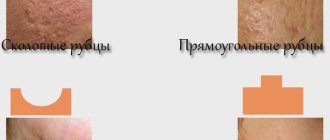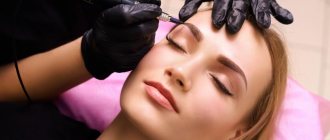History and development of the method
A laser is a beam of light that is amplified by stimulated radiation. The use of this technology in the field of tattoo removal began in the 60s of the twentieth century, when it was proposed to be used for these purposes by the US physicist Theodore Maiman. Until 1965, a ruby laser was used. Developments such as a yttrium aluminum garnet (neodymium) laser, an argon laser, and later a carbon dioxide laser were also introduced. Unfortunately, this method was not without its drawbacks: most often, scars and cicatrices remained at the site of removal.
Note! Over the years, the techniques have been improved, and today they are widely used in cosmetology practice.
Today this method is actively used
The next significant step in the development of laser technology came in 1983, when the theory of selective photothermolysis, or SPT, appeared. It was a breakthrough - scientists and doctors were able to figure out exactly how the laser affects the skin, and the first laser systems were designed for use in cosmetology.
Use of laser technology today
In cosmetology, laser exposure is divided into two types.
- Ablative effect. In this case, a kind of “erasing” of the upper layer of the epidermis occurs, on which an unwanted pattern is applied. In order to understand the technology, you can consider the example of a carbon laser: a directed beam of light heats water in tissues, and then causes the effect of its evaporation in a short time, simultaneously with the elimination of epithelial particles due to protein denaturation. Thulium and erbium lasers have the same effect - their beams are absorbed by liquid structures many times more strongly.
Ablative effect - Selective laser action: damages formations located inside or under the skin. In this case, no damage is caused to the skin itself. To perform the procedure in this way, a special laser with certain parameters of wavelength and exposure mode is required. Laser light is absorbed by dyed fabrics, destruction and discoloration occurs due to the photothermolytic effect. Undyed fabrics remain intact. Wavelengths of a certain length are selected for each color of paint used when applying the tattoo. After the procedure, laser-damaged cells and dyes that have undergone decay are eliminated independently through the lymphatic system and exfoliation of skin particles in about a month.
Selective laser action
In general, complete removal of a tattoo will require several procedures, the total period from a month to a year - the duration depends on the depth of the ink and the amount of work.
Note! Usually, the second type of exposure does not leave any traces on the skin - the wave impulse is too small to cause severe damage to the skin.
The secret of the method
Laser radiation is light with high energy. Getting under the skin, it evaporates cellular and intercellular fluid in the areas where it was directed. The laser is controllable: it can be configured so that water evaporates only from areas where there is an accumulation of pigment - the dye used to make the tattoo. These rays also have one more wonderful property: it is enough to change the length of the emitted wave - and now they “see” only a certain color.
At the cellular level, tattoo removal occurs as follows:
- the laser heated the pigment injected into the skin;
- the liquid in the cells containing the dye has evaporated;
- the pigment granules were “seen” by skin immune cells, which sent them to the lymphatic capillaries;
- With lymph, the dye was removed from the body without harm to it.
How is the procedure done?
The very essence of applying a tattoo is that the pigment (ink, dye) is applied not to the surface, but directly inside the skin cells, as a result of which clusters of microscopic drops of the dye are formed.
Note! Previously, tattoos were removed using very traumatic methods, such as surgical excision of the skin, scraping - all this led to the formation of large, ugly scars. In the mid-twentieth century, lasers began to be used, this technology was improved until by the 90s it became the most popular in this field.
Previously, tattoos were removed by excision of the skin
Factors influencing the result of work.
- Characteristics of a tattoo . These include the composition of the pigment, the size and location of the pattern, the depth of the dyes, the tool used for application and the condition of the skin (presence of scars).
- Skin type . The pigmentation itself is important – whether the skin is dark or light, and the health of the dermis. All this is important for the correct selection of the operating mode of the laser device.
- Laser characteristics . Such details of the laser operation as the wavelength and duration of the incoming pulse are taken into account. In order to eliminate all pigment particles and not cause a traumatic effect on the skin, it is necessary to direct laser energy of a suitable wavelength - this is not always easy, some shades are quite problematic to remove, but it is easiest to work with black pigment.
The effectiveness of removal depends on several factors
The QS (Q Switch) laser has been adopted as the generally accepted standard for laser removal of patterns on the skin. It has the ability to select the required wavelength, taking into account the color of the skin and the pigments used, as well as the corresponding duration of the pulse. Typically, getting rid of a tattoo using such a laser requires several sessions, each of which is carried out once a month.
Q switch laser
Contraindications to the procedure
A general list of conditions in which tattoo removal is contraindicated:
- any diseases of the cardiovascular system;
- mental pathologies;
- skin diseases, dermatitis, eczema, etc.;
- pregnancy and breastfeeding;
- individual intolerance.
In order to remove a tattoo, it will take quite a lot of time and several sessions with a cosmetologist. Typically, one medium-sized drawing requires about 7-8 procedures (each of them is carried out approximately once a month).
The process will be long and very painstaking; it will require enough patience and resources to complete it. It is recommended to contact highly qualified specialists who work on modern equipment in advance in order to avoid serious problems later.
Removing a tattoo with a laser is not a quick process
During the procedure, you may notice a fading of the pattern, but at first this is only a temporary effect that soon disappears. After the first sessions, the color saturation will gradually return - you should be prepared for this.
Note! The process of removing drawings can be quite painful; in order to avoid this and make the procedure more comfortable, local anesthesia and mild sedatives are used.
An installation with a cooling effect through cooled air is also usually used - this method of reducing pain began to be used relatively recently, and has already received the first positive reviews. Ice compresses and local anesthetic creams can also be used. In some cases, injections of an anesthetic drug (such as lidocaine) are used directly into the treated area. In addition, modern laser systems allow manipulations to be carried out with greater comfort.
The skin is numbed so that the patient does not experience discomfort.
Are there any contraindications for laser tattoo removal?
People who are thinking about how to remove a tattoo with a laser should be aware of the possible consequences of the procedure. The most common side effect after laser correction is skin pigmentation. Often after a session, people develop herpes, rashes, sneezing and vomiting. As for contraindications, tattoos should not be removed using this method for people with the following indications:
- diabetes;
- epilepsy;
- pregnancy and lactation;
- presence of pacemakers or prostheses;
- skin diseases (eczema, psoriasis);
- infectious diseases;
- hypertension, ischemia, arrhythmia;
- fresh tan
Selection of specialist and clinic
Before going to a clinic for tattoo removal, you will need to find out whether the specialists working there have a license to perform these manipulations; read reviews from other clients. A plus will be the availability of a doctor’s portfolio with photographs before and after tattoo removal in the public domain. Basic list of questions to ask during consultation.
- What equipment is used during the session (it is better if the latest generation laser is used, which, unfortunately, not all clinics can afford).
- Anesthesia techniques involved.
- What safety guarantees are given during the procedure: the doctor and the patient must wear safety glasses, a separate room is allocated for the laser, and the cosmetologist must have a special permit to work with this type of equipment.
- Ask for a list of possible side effects from the procedure, as well as any guarantees provided.
It is important to know everything about the procedure
Note! Specialists from a trustworthy clinic should not have any difficulty answering these questions, and the lack of adequate comments can be alarming.
Other Tattoo Removal Methods
There are also other methods of drawing pictures without using laser technology.
- Skin resurfacing: To perform this procedure, you will need to scrape the top layer of skin using a special diamond-coated device. This is a rather dangerous procedure, since there is a high risk of infection; you will need to wear a bandage for a long time and treat it with antiseptics. Often causes welts and scars. Usually costs much less than other methods.
- Surgical removal. The most traumatic method of tattoo removal involves cutting out part of the skin with the applied design. Scars cannot be avoided here.
- Use of chemicals. The pattern is removed using bleaching ointments and piercing it with a special needle. This is a long procedure that requires a high level of professionalism; not every cosmetologist undertakes to carry it out.
- It is also possible to treat the tattoo with liquid nitrogen - the upper layer of the epidermis is subjected to necrosis and is removed. This is a very painful and lengthy method, but cheap.
- The electrocoagulation method works in a similar way, in which the tattoo is exposed to high-frequency currents. Severe burns and scars may occur.
There are other tattoo removal methods, but they are not considered as effective.
In this age of widespread dissemination of information, you can easily find reviews from real people who have experienced tattoo removal procedures in one way or another, so it is better to familiarize yourself with them in advance.
Note! There is no need to save money on this procedure.
How to remove tattoos at home?
Not everyone is satisfied with the possibility of salon removal of unwanted tattoos; many prefer to do this work on their own at home. This practice cannot be called safe, given that many techniques are now available that do not require resorting to such methods.
All methods that you can use to remove tattoos at home are truly dangerous, so the methods below are provided for informational purposes only. We consider it necessary to warn that such methods are not only very painful, but are often either completely ineffective or leave serious crippling scars and can have disastrous consequences for health.
You can even remove a tattoo at home, but it is quite dangerous
Potassium permanganate compresses in the picture lead to the formation of ulcers and burns, which are subsequently difficult to treat. Alkali gives the same effect.
Using iodine is a lengthy, less dangerous, but practically ineffective process that can take several months.
Celandine juice is a toxic substance that can cause severe burns and allergic reactions.
When using salt, severe pain occurs, making the procedure almost unbearable.
Even with the best outcome of using such methods, serious damage, scars and scars will remain on the skin. In the worst case, you can get burns, poisoning, and infection entering the wound, leading to blood poisoning.
Most likely, after removing the tattoo yourself, scars will remain on the skin
Note! Based on this, we can conclude that the only effective way that does not cause harm to health is the help of a qualified cosmetologist.
Tattoo removal methods
First of all, they are divided into:
- non-selective;
- selective.
In the first case, the pattern is removed along with the layer of skin it covers. Such methods are not only painful, but also dangerous in the sense that scars may remain on the skin. The advantages are that removal is guaranteed, often in one procedure.
In the second case, gentle methods are used to remove the pigment with virtually no tissue damage. Disadvantage: Multiple treatments may be required. And the cost of such removal will be much higher. Although, if you take into account that in the first case you will probably also need to remove scars, the price issue will disappear by itself.
Tattoo pigment removal
How exactly can you get rid of a tattoo? What are the advantages and disadvantages of each method?
In other words, masking a tattoo with a dye that is close to the color of the skin. The technique is outdated, since today there are many other more effective ways to make a drawing invisible. Its disadvantage is that with the most careful approach to this matter, it is unlikely that it will be possible to choose exactly the shade that will be indistinguishable from human skin, especially if you need to mask a large pattern that is distinguished by bright pigment. It is used by those who want to carry out the procedure simply, quickly, with minimal costs and without major claims to quality.
Dermabrasion
It consists of a mechanical effect on the skin. Essentially, this is skin polishing with devices that have attachments with hard brushes or an abrasive surface. This method can be effective in removing tattoos from a large area, but it is quite traumatic and requires a long recovery period, and is quite sensitive (the use of an anesthetic is a prerequisite).
Dermabrasion is not suitable if you need to remove tattoos from intimate and sensitive areas. In addition, dermabrasion may leave scars. The method is not suitable for removing a pattern if the pigment has penetrated into the deep layers of the skin.
Surgical excision
Produced in two ways:
- a dermatome (a special instrument that allows you to remove a small area of skin) - with superficial penetration of the pigment into the epidermis and a small pattern;
- by excision of a large fragment of skin followed by stretching adjacent tissue over the damaged area or, if this is not possible, by transplanting skin from some area of the body (for example, from the abdomen or thigh).
In both the first and second cases, pain relief (anesthesia), suturing, and a long rehabilitation period are required. Despite the high efficiency of the method, it is resorted to when another, more modern method cannot remove the drawing.
The reasons are not only high trauma and painful sensations, but also that problems may arise with tissue healing after plastic surgery, and the procedure itself requires highly qualified and appropriate skills from the doctor, otherwise, instead of tattoos, the body will be decorated with already very noticeable scars.
Chemical peeling
A concept well known in modern cosmetology. As a result of exposing the skin to a corrosive chemical, for example, trichloroacetic acid for medium peeling and phenol for deep peeling, the doctor ensures that it penetrates into the superficial and deep layers of the skin. A burn of the epidermis occurs, as a result of which the tissue is destroyed and rejected along with pigment particles.
A crust appears at the site of the tattoo, under which an active process of skin regeneration occurs. When the crust falls off, young skin will remain underneath, free from the image that once adorned this place.
By resorting to chemical peeling, you can “clean” a large area of skin from a tattoo. However, this method has some disadvantages:
- pain (it is minimized with the help of anesthetics or general anesthesia);
- the ability to “work” mainly with superficial tattoos;
- uneven penetration of the substance under the skin, which can lead to uneven removal of the tattoo;
- long-term rehabilitation;
- possible intolerance to the components of the substance used;
- the risk that scars will appear after peeling (if the area being treated is large and the qualifications of the specialist are not high enough).
Cryodestruction
A tattoo can be removed by “freezing it out,” or more precisely, by applying liquid nitrogen to the design. Under the influence of the refrigerant, the upper layers of the epidermis are frozen, tissues die and are further rejected, in place of which blisters appear. Soon they open, giving way to a crust, under which, again, new tissue is formed.
Cryodestruction
The main thing is not to interfere with the process: both the blisters and the crust should disappear by themselves. After ten to fourteen days, in rare cases, no trace remains of the design (mostly these are superficial tattoos); more often, it becomes barely noticeable due to severe discoloration (usually no more than 10% of the pigment remains in the epidermis).
The procedure is quite effective and carried out quickly.
- The sensation of pain may be present, but it is not comparable to those described above.
- A possible risk is the appearance of a scar.
- The disadvantage is that it is unlikely that you will be able to get rid of the tattoo completely.
Electrocoagulation
The tattoo is targeted with a high-frequency electrocoagulator, as a result of which the tissue is dehydrated and the design is burned out. Effectiveness – lightening of the pattern by approximately 90% (as with cryodestruction). After the procedure, a crust appears - it disappears on average after 7-10 days, revealing young pink skin. There is a risk of scarring. Pain is felt, so it is advisable to use a local anesthetic.
Cold plasma coagulation
Unlike electrocoagulation, the effect on a tattoo is carried out in a non-contact way: a high-frequency electric current is generated in the metal tip of the device at some distance from the skin, after which it hits the design. Tissue evaporation occurs, leading to the destruction of the tattoo.
In this way, tattoos of different depths and sizes can be removed, since the doctor has the ability to adjust the operating mode of the device.
The procedure is popular because the risks after it are minimal:
- there are practically no traces left;
- the tattoo is completely removed;
- the wound heals faster due to the fact that there was no contact between the device and the skin;
- the pain is quite tolerable.
Laser removal
The laser (Alexandrite, neodymium, argon, ruby, as well as pulse sources operating on copper vapor, etc.) is selected individually depending on the characteristics of the pattern. The laser beam acts in a targeted manner without affecting adjacent tissues. The shock wave that is generated during operation of the device destroys pigment particles, which are then absorbed by phagocytes and excreted through the lymph.
Laser operating principle
Advantages of the method:
- minimal pain;
- quick procedure;
- not long rehabilitation;
- the ability to remove patterns of any size and depth, including in intimate and delicate areas.
Disadvantages include the need for several sessions (not always) and high cost.
Despite this, this method remains one of the most popular.
Basic myths about laser tattoo removal
Myth 1. Any center that has a laser machine is suitable for tattoo removal.
There are indeed a very large number of such centers, but the quality of the services provided does not always meet the required level. Before carrying out the procedure, a detailed consultation with a dermatologist is required, who should ideally conduct the session. A doctor's monitoring of the process will help to promptly prevent side effects such as bleeding, infection or scarring.
It is better to contact clinics that have a sufficient number of positive reviews about this procedure.
Myth 2. Using a laser you can quickly and easily get rid of a boring pattern
A laser is not an eraser, and its use does not involve a quick tattoo removal process. There are patients whose full cycle of sessions to remove unwanted patterns on the body lasted more than a year or even two, with sessions performed once every 2-3 months. This procedure is incomparable with simpler manipulations, such as removing unwanted hair. When using a laser, pigment particles in the skin are eliminated and then removed by the immune system.
Note! After the session, a long and complex process of regeneration and recovery is required, accompanied by bleeding, pain and swelling.
It will not be possible to quickly remove a tattoo with a laser, especially if it is of an impressive size.
Myth 3. This is a painless process.
The absence of pain and discomfort can only occur if local anesthesia methods are used. Moreover, if the size of the tattoo is large, then a lot of time is spent. Only a doctor can inject lidocaine or another active anesthetic; if the procedure is performed by a person without medical education, then this method of pain relief is not used. Removing small tattoos can also be very unpleasant, since the pain depends not only on the size, but also on the color of the pigment. The only difference will be that when removing small tattoos, the process will take significantly less time.
Discomfort may be felt during the process if no anesthesia is used.
Myth 4. Laser tattoo removal is safe in any case.
Unfortunately, not everyone endures this procedure without loss. This can be a rather difficult process for patients with darker skin tones (this is due to the way the laser itself works, which can “target” not only the pigment in the tattoo, but also the melanin contained in the skin).
Note! Therefore, we can say that the darker the patient’s skin tone, the more difficult it is to use a laser in the procedure, and the much higher the risk of unwanted pigmentation and burn injuries.
People with dark or dark skin will have a more difficult time removing a tattoo.
Myth 5. Tattoo removal is very easy
Skin patterns are completely different. For example, the easiest way to get rid of black pigment is with green and blue colors, but doing something with a yellow, purple or white tint is almost impossible. Laser waves of different lengths are used to process their pigment colors. The complexity of the approach can be with
Avoid the Chinese
Remember that the result depends not only on the color of your tattoo, but also on the device that will be used to remove it. The one made in the USA costs about a hundred thousand dollars. It is not surprising that many salons and medical centers do not buy expensive “Americans,” but their Chinese counterparts, whose price does not exceed four thousand bucks. But, unfortunately, budget “Asians” cope with the task much worse - after their exposure, the tattoo is “readable” on the skin: and even if it is barely noticeable, there can be no talk of ideal cleanliness and smoothness in this case. Therefore, before you give yourself into the hands of the first master you come across, be sure to ask him to show the documents for the device, where you can find out about the country of origin.
Consequences of intervention
Up to two days after the tattoo removal procedure, pain and discomfort may be observed - this is a normal reaction. You can relieve symptoms by using a cold compress with ice. Also after the session you may experience slight swelling, changes in pigmentation and bleeding. The skin may become red. After about 1-2 days, the symptoms stop, and a crust appears at the tattoo site, which disappears after two weeks.
Note! If you have to deal with prolonged pain, severe redness or swelling that does not subside, you must contact your surgeon to prevent possible complications.
Some discomfort may be felt after the procedure
The process of removing pigmentation can continue for up to two months; the tattoo will gradually fade and disappear. The time spent on this process depends on the individual characteristics of the organism.
Expert opinion
Alexander Tsypkin, director of the Dragon tattoo salon, leading specialist in tattoo removal:
Using a laser device, you can remove not only a tattoo, but also unsuccessful permanent makeup. The technology will be the same as when removing tattoos. However, there is one nuance associated with the elimination of lip contour tattooing: burgundy and pink tones will most likely turn gray after the first procedure. This inevitable effect that occurs after the paint interacts with the laser will subside within a couple of weeks. And do not forget that if you want to achieve the best results in removing tattoos or permanent makeup, you must comply with the main requirement - do not expose the laser-treated area to the sun. Otherwise, delicate, unprotected skin may burn or become covered with pigment spots.
Number of procedures and waiting time for results
Depending on the characteristics of the pigment and the size of the tattoo, you may need from two to twelve procedures, based on the results of which you can evaluate the result. Be sure to stay in touch with your doctor and let him know about any alarming changes in your condition. Don't hesitate to ask if you have any questions regarding your well-being.
Typically, 2 to 12 procedures are required
Laser tattoo removal procedure
The procedure itself consists of destroying the paint pigment with intense light radiation. At the same time, tattoos made in black are a little easier to remove. It begins with diagnostics, during which they determine how deep the paint lies and which laser is best to remove it.
Next, they put protective glasses on you and fire a test salvo at you, over a small area of your skin, to determine what laser power is best to work with you. When this has been decided, the mixing process begins, immediately after which an ice pack is applied to you and an ointment is prescribed for further care of the treated area.
During the session, the beam affects the paint and the tattoo begins to lighten and then darken - this is the destruction of the pigment, which is then removed from the body. And so on until the tattoo disappears completely - after the last session.
In order to burn out a black tattoo from you, it will take from two to eight sessions, and if you decide to remove a colored one, then all of fifteen. At the same time, there is at least a month break between each session. The deeper the paint was introduced under the skin, the more sessions will be required. The process ultimately takes a long time - from a couple of months to several years, and in any case you should not expect instant results.
In this case, four types of lasers are used: ruby, alexandrite, neodymium and erbium.
- Ruby works the slowest and cannot remove deep and multi-colored tattoos. Used to remove blue, black and green tattoo colors
- Alexandrite is the same as ruby, but works faster
- An erbium laser, working on the principle of laser vaporization, removes multi-colored tattoos if they are shallow, otherwise it leaves scars.
- Neodymium, due to light waves of different lengths, can cope with any tattoo, but it is also not always used. Also, a neodymium laser cannot remove yellow paint - it “does not see” it.
What complications can you encounter?
In most cases, the procedure is easy and without complications. If there are any risks in your individual case, your doctor will explain them at your first consultation.
List of complications that may occur:
- hematomas, accumulations of fluids during pigment removal;
- infection;
- bleeding;
- problems with sensitivity in the treated area;
- the appearance of scars;
- allergy;
- no primary effect.
Complications are rare, but they are still possible
In addition, there is a possibility of encountering specific changes that are associated specifically with tattoo removal:
- problems with pigmentation in the treatment area;
- changes in the structure of the skin;
- in rare cases - darkening of the pattern.
Note! Risks can be minimized by strictly following the rules and advice given by the surgeon after completion of the procedure.
Reviews
Marina, Vladimir
“I had my “youth mistake” removed - a tattoo on my neck - using a neodymium laser. I can’t say that it hurt a lot, but I felt discomfort. This is understandable - the skin on the neck is quite delicate. But the main thing for me was to finally remove the tattoo, because it was really ruining my life. It took me 10 sessions because the tattoo itself was quite large. But the cosmetologist told me that the pigment was not deep, otherwise even more sessions would have been required. Gradually the tattoo became lighter, and now it is completely gone. I'm very happy".
Patients confirm that laser tattoo removal is truly effective
Ivan, Moscow
“I got a tattoo a couple of years ago, but now I just don’t like it anymore. I decided to remove it, fortunately, now it is possible to do it with a laser. I have a high pain threshold, I did not experience any discomfort. Tattoo removed in 8 sessions. The skin is now clean, there are no scars left. All good".
The worse the paint, the faster
Don’t think that after the first session you will get rid of the tattoo. To ensure that not a trace remains of the image, you will need from three to five procedures with an interval of thirty days (each will cost about 3,500 rubles). The number of sessions that the master will prescribe for you depends primarily on the paint driven under the skin. If you got a tattoo in a good salon, be prepared to spend a long time with the laser. Your guy, who impaled himself on a tiger in artisanal conditions with ink, was luckier in this case. It is much easier and faster to remove than professional paint. The color of your drawing is also important: black and blue paint are the easiest to destroy, red and orange are worse, and green paint is almost impossible to completely remove. For the future, take this into account and the next time you are planning to get a tattoo, avoid emerald and marsh shades. Don’t expect the final result to appear immediately after the last “laser” session ends. The skin needs at least six months to fully recover. After this, be sure that no one will guess that your shoulder was once decorated with a tattoo.
Photos before and after
Photos before and after a course of laser tattoo removal procedures No. 1
Photos before and after a course of laser tattoo removal procedures No. 2
Photos before and after a course of laser tattoo removal procedures No. 3
Contraindications and complications
Some report side effects such as skin discoloration or hyperpigmentation. There is also a risk of infection when removing a tattoo with a laser. If you use it frequently, you may get burned.
laser tattoo lightening: before and after photos
When removing eyebrow tattoos with a laser, as well as tattoos on other parts of the body, you need to remember the contraindications:
- Fresh tattoos;
- Inflammatory processes or mechanical damage in the area of the drawing;
- Oncology;
- Diabetes.
Before and after the procedure, you should not sunbathe, drink antibiotics or use products containing alcohol.
Doctors performing laser tattoo removal procedures in Perovo:
BOGDANOVA ANNA
Dermatocosmetologist Plastic surgeon
VAGANOV NIKOLAY
K.M.N. Plastic surgeon
ROMANOVA LIANA
Dermatovenerologist Cosmetologist
KONOREZOVA VICTORIA
Dermatovenerologist Cosmetologist
KARELINA NATALIA
Nurse
SKORODIMOVA MARINA
Nurse
INDZHGIYA LIA
Gynecologist-endocrinologist, D.M.N. Ultrasound diagnostic specialist 23 years of experience
GORELOVA IRINA GEORGIEVNA
Ultrasound diagnostic doctor
32 years of experience
You can sign up for a free consultation with our specialists; the doctor will tell you in detail about the tattoo lightening procedure and the number of procedures required. More detailed information about laser tattoo removal can be found on the official DasClinic website.
Reviews from patients who have undergone laser lightening and complete tattoo removal:
August 21
Name: Valeria
Can you remove tattoos with liquid nitrogen?
22 of October
Name: Olga (Eastern Administrative District, Perovo district)
The fashion for tattoos is constantly changing, today one thing is fashionable, and tomorrow another. Despite this, I still took a risk and got a tattoo on my body. I went to a beauty salon for this, not far from the house where the tattoo artist worked. I liked tattooing for a long time, but as I got older I realized that this type of art was not for me. I went to the clinic to have the tattoo removed from my leg for a fee. The procedure took about half an hour, and my annoying tattoo was removed absolutely painlessly in 3 sessions. I am very grateful to the clinic staff.
03 October
Name: Artem (Moscow, Perovo)
Unlike others, I came to DasClinic not to remove my tattoo, but to lighten it. Overall I was happy with it, but I wanted to make some stylistic changes. I was pleasantly surprised when the doctor understood the tasks the first time and carried out the procedure as carefully as possible. And the money turned out to be much less than planned. In general, I'm pleased. Nikolay, respect for your work and special thanks for the fascinating conversation. I’ll add that laser removal is less painful than other methods (believe me, I tried a bunch of them)
September 30th
Name: Alina Starostina (Novogireevo)
I went to the clinic with my daughter. My idiot, in a bet with her friends, tattooed some kind of geometric pattern on her hand, which she didn’t even deign to inform me about. At first I didn’t want to resort to laser tattoo removal; I remember from my years that this procedure was not pleasant, but there wasn’t much of a choice. Thanks to Nikolai Vladimirovich, he did everything clearly and accurately. My daughter didn’t even cry while he was working on her. It’s good that there are still such specialists in our city.
September 13
Name: Yuri (Moscow, Sokolinaya Gora station)
I recently got a tattoo on my arm, everything would have been fine, but in the summer, when my arm became visible without clothes, problems began at work. There was no choice, it was necessary to get rid of her and quickly. I went to a clinic that offers inexpensive laser tattoo removal. The tattoo is gone, the scars are there too. The problems at work ended and, accordingly, my nervous work days ended.
25-th of August
Name: Angelina (Moscow, Novogireevo district)
In the winter I got a tattoo on my lower back, choosing a place specifically so that my parents wouldn’t see it, even despite my adult age. But I was unlucky and soon everyone, including my family, found out about her. The result of my independence is a huge scandal. We live near the Perovo metro station, where the Das Clinic clinic is located, where my mother enrolled me in order to remove the ill-fated tattoo. Good doctors held a consultation and told us that 3 laser tattoo removal procedures would be enough and there would be nothing left of it. Generally speaking, soon there was really nothing left of my tattoo, thanks to the equipment and professionals of this clinic. I say thank you.
09 August
Name: Irina Novikova (Moscow, Entuziastov Highway)
Tattoos have always been my passion. And so in winter I decided to make another one. My master was ill, so I decided to turn to someone else. As a result, the wrist was disfigured by a crooked little scribble, which only vaguely resembled my sketch. I had to urgently look for a place where this disgrace could be removed. As if by order, I came across an ad for DasClinic on the Internet. After the first consultation, I understood: I was in the right place. The staff here is friendly, the doctors are immediately obvious that they understand their business, the offices themselves (which is extremely important for me personally) are sterilely clean. I made an appointment with a nice girl, Anna, and didn’t regret it for a minute: thanks to her help, laser tattoo removal (as opposed to application) was absolutely painless. I won’t say that the drawing has disappeared completely, but now it can be completely covered with a normal one. My best recommendations.
July 13
Name: Ildar (VAO, Perovo)
I think my story will be familiar to many. In his youth, to prove to the girl the seriousness of his intentions, he tattooed her name on his back. But the love has passed, the tomatoes have wilted, but the reminder remains. Do I need to explain that this inscription was extremely annoying to my new girlfriend? Therefore, I decided not to go into conflict and go to the clinic, which was recommended by a friend (he came here with a similar problem last winter). Thanks to Anna (alas, I didn’t remember her last name), after several appointments there was almost no trace left of her tattoo. Now the girl is hinting at getting a tattoo with her name. I think I’ll please my beloved, but if anything happens, I now know where to turn. The removal process is of course very unpleasant and long - but everything can be solved)
07 April
Name: Polina (VAO, Shosse Entuziastov metro station)
I got my eyebrows tattooed back in the years when this procedure first appeared in our city. The result is black eyebrows with a blue tint, which look more like a drawing with a felt-tip pen. It took me a long time to gather my thoughts, but I still decided to contact Das Clinic for laser tattoo removal. I looked at the photo after the procedure and realized that I simply needed it. The clinic’s equipment is designed to completely remove tattoos in a couple of sessions. And so it happened. In just 2 sessions, not a trace remained of my terrible eyebrows. I really liked the effect. Now I will be more careful in choosing a tattoo artist.
Author of the article : Gadzhibekova Liana Gadzhibalaevna - dermatovenerologist, cosmetologist. Work experience more than 7 years. Specializes in injection procedures, contouring and 3D modeling, hardware cosmetology and thread lifting. https://roksa.ch Regular participant in international forums and congresses dedicated to medical cosmetology. You can view official certificates and supporting documents here.
Author's contacts on social networks:











